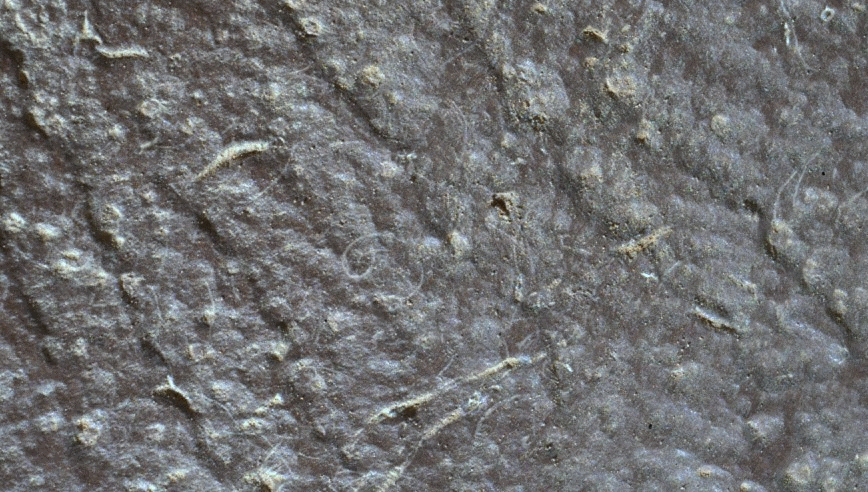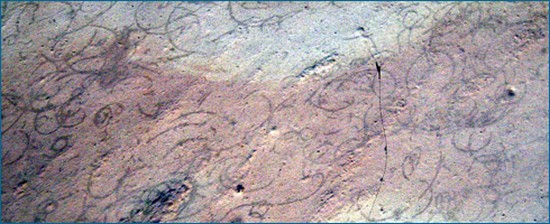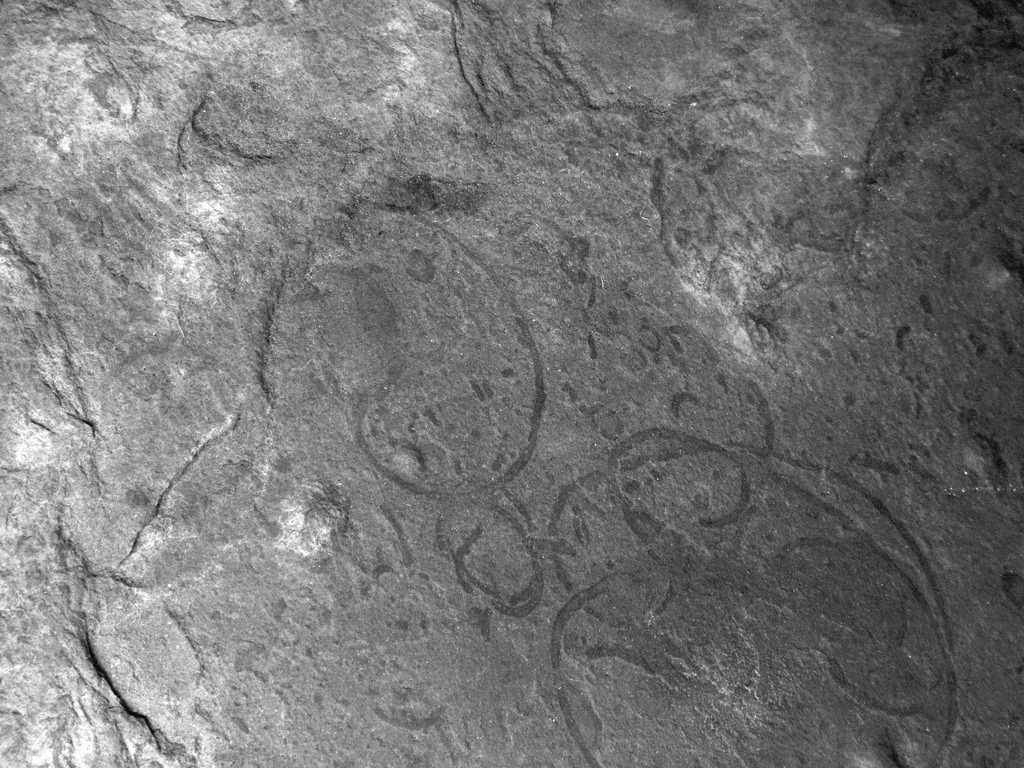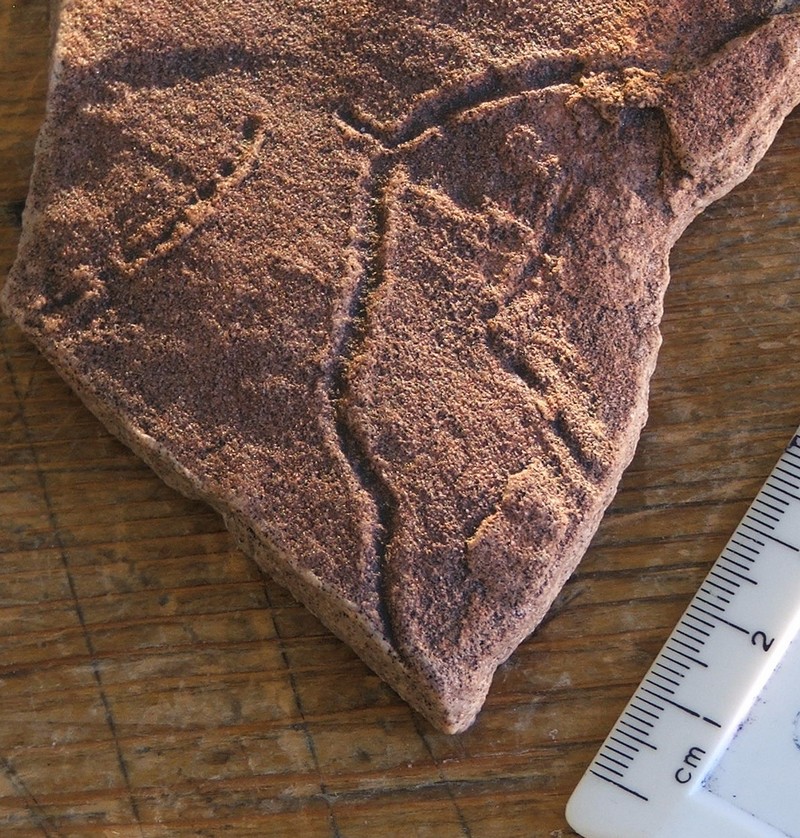It looks like you're using an Ad Blocker.
Please white-list or disable AboveTopSecret.com in your ad-blocking tool.
Thank you.
Some features of ATS will be disabled while you continue to use an ad-blocker.
share:
The image below just came in from Curiosity's MAHLI cam, it's a close-up shot of a rock showing features that - at least to me - are reminiscent of
fossilized biological life forms. Here's an animated GIF highlighting the more noteworthy shapes and streaks:
 (Click for FULLSIZE original
image)
(Click for FULLSIZE original
image)
These features (especially the whirly thin tube) instantly reminded me of algae: Grypania spiralis was an early form of algae on Earth, here some fossilized remains (for comparison):
 Source Image
Source Image
 Source Image
Source Image
Yet another biological explanation could be that these are "trace fossils" left behind by organisms making their way through the ancient soil, here's an example (from Earth):
 Source Image
Source Image
Personally, I think these images are unique and I can't remember having seen anything comparable in previous MAHLI images. The twisting and whirling form of these tubes are quite remarkable IMO and the exciting thing is that it's not a single isolated feature but a great many of them on this particular rock (including additional shapes that somehow resemble other primitive organisms known from terrestial fossils).
Would be great to hear from the geologists among us whether or not there might be any geological processes that produce such patterns (geochemistry?).
Thanks for reading up to here and I look forward to your thoughts on this!
SOURCES AND LINKS:
--------------------------------------------------------------------
1. Curiosity / MAHLI image (sol 1416)
2. Grypania Spiralis/Proterozoic Eon/Earth (for comparison)
3. The Earliest Life / 2 mya old fossilized algae
4. Ediacaran Trace Fossil
5. Curiosity MAHLI Archive for sol 1416
6. ATS Thread: The Case For Past Life On Mars / Eagle Crater

These features (especially the whirly thin tube) instantly reminded me of algae: Grypania spiralis was an early form of algae on Earth, here some fossilized remains (for comparison):


Grypania Spiralis
Grypania is an early, tube-shaped fossil from the Proterozoic eon. The organism could have been a giant bacterium or bacterial colony, but because of its size (over one centimeter) and consistent form, is more likely to have been a eukaryotic alga. The oldest probable Grypania fossils date to about 2.1 billion years ago and the youngest extended into the Mesoproterozoic era.
Yet another biological explanation could be that these are "trace fossils" left behind by organisms making their way through the ancient soil, here's an example (from Earth):

Personally, I think these images are unique and I can't remember having seen anything comparable in previous MAHLI images. The twisting and whirling form of these tubes are quite remarkable IMO and the exciting thing is that it's not a single isolated feature but a great many of them on this particular rock (including additional shapes that somehow resemble other primitive organisms known from terrestial fossils).
Would be great to hear from the geologists among us whether or not there might be any geological processes that produce such patterns (geochemistry?).
Thanks for reading up to here and I look forward to your thoughts on this!
SOURCES AND LINKS:
--------------------------------------------------------------------
1. Curiosity / MAHLI image (sol 1416)
2. Grypania Spiralis/Proterozoic Eon/Earth (for comparison)
3. The Earliest Life / 2 mya old fossilized algae
4. Ediacaran Trace Fossil
5. Curiosity MAHLI Archive for sol 1416
6. ATS Thread: The Case For Past Life On Mars / Eagle Crater
edit on 31-7-2016
by jeep3r because: formatting
Why wouldn't there have been some kind of life on Mars? If earth did why not Mars? Mars just had an unfortunate end of its core solidifying and its
magnetic field deteriorating.
I guess the real question is how far did life evolve on Mars before its magnetic field and its core failed? And what does it really matter to us?
I guess the real question is how far did life evolve on Mars before its magnetic field and its core failed? And what does it really matter to us?
a reply to: chrismarco
Not amazing that they have found potential PROOF, not theories and logical talk?
Not amazing that they have found potential PROOF, not theories and logical talk?
a reply to: jeep3r
Well, I know of no purely geological process which could have caused these shapes to occur in the rock, but I, like you instantly recognise the algae like appearance of these features. I will await, with baited breath, any further analysis from the scientific community, on this matter.
Many thanks to you, jeep3r, for bringing this to our attention!
Well, I know of no purely geological process which could have caused these shapes to occur in the rock, but I, like you instantly recognise the algae like appearance of these features. I will await, with baited breath, any further analysis from the scientific community, on this matter.
Many thanks to you, jeep3r, for bringing this to our attention!
originally posted by: Orionx2
Why wouldn't there have been some kind of life on Mars? If earth did why not Mars? Mars just had an unfortunate end of its core solidifying and its magnetic field deteriorating.
I guess the real question is how far did life evolve on Mars before its magnetic field and its core failed? And what does it really matter to us?
At one point of time mars looked just like earth did. So i imagine there is a plethora of fossils (and possibly things that are still alive) deeper underground away from the radiated surface. I wouldn't be surprised if there were actual animals not unlike earth (in fact i bet thats how earth got seeded in the first place. One massive volcanic eruption or asteroid would send rocks spiraling towards earth.)
It's all so very exciting, And so are these images. I hope NASA makes a statement soon
originally posted by: argentus
a reply to: jeep3r
Interesting images! Good find. I wonder......... do you have any idea of the scale of the Mars images?
Thanks, argentus! A quick search turned up this image with scale information regarding MAHLI:
msl-scicorner.jpl.nasa.gov...
Note the 1mm scale bar in the lower right hand corner ...
I wish they would look a little harder. I am still missing my Iludium Q-36 Space Modulator.
originally posted by: Tjoran
originally posted by: Orionx2
Why wouldn't there have been some kind of life on Mars? If earth did why not Mars? Mars just had an unfortunate end of its core solidifying and its magnetic field deteriorating.
I guess the real question is how far did life evolve on Mars before its magnetic field and its core failed? And what does it really matter to us?
At one point of time mars looked just like earth did. So i imagine there is a plethora of fossils (and possibly things that are still alive) deeper underground away from the radiated surface. I wouldn't be surprised if there were actual animals not unlike earth (in fact i bet thats how earth got seeded in the first place. One massive volcanic eruption or asteroid would send rocks spiraling towards earth.)
It's all so very exciting, And so are these images. I hope NASA makes a statement soon
I hear you but at the same time I don't know.... Why would Earth be Seeded from Mars and not be Seeded by whatever seeded Mars? Mars is a long way off.
originally posted by: Orionx2
originally posted by: Tjoran
originally posted by: Orionx2
Why wouldn't there have been some kind of life on Mars? If earth did why not Mars? Mars just had an unfortunate end of its core solidifying and its magnetic field deteriorating.
I guess the real question is how far did life evolve on Mars before its magnetic field and its core failed? And what does it really matter to us?
At one point of time mars looked just like earth did. So i imagine there is a plethora of fossils (and possibly things that are still alive) deeper underground away from the radiated surface. I wouldn't be surprised if there were actual animals not unlike earth (in fact i bet thats how earth got seeded in the first place. One massive volcanic eruption or asteroid would send rocks spiraling towards earth.)
It's all so very exciting, And so are these images. I hope NASA makes a statement soon
I hear you but at the same time I don't know.... Why would Earth be Seeded from Mars and not be Seeded by whatever seeded Mars? Mars is a long way off.
There are a lot of theories, mars is just one of them.
a reply to: jeep3r
Ah! Thanks! I don't know diddly about theoretical (I believe very likely) martian biology, but that size seems fairly consistent with corresponding Terrestrial creatures.
Very exciting. I can't WAIT until we have boots on the ground w/vehicles and human analysis and testing on Mars. Of course, there is always the concern.......... will we get to see the 'good stuff?' I hope to be alive that long.
ETA: The image you just posted seems more granite-like, with what appears to be quartz in it. Doesn't look quite the same as your OP photo with the nodules and what looked to me to be more sandstone-like formations. Not challenging you, just pointing out what I see.
Ah! Thanks! I don't know diddly about theoretical (I believe very likely) martian biology, but that size seems fairly consistent with corresponding Terrestrial creatures.
Very exciting. I can't WAIT until we have boots on the ground w/vehicles and human analysis and testing on Mars. Of course, there is always the concern.......... will we get to see the 'good stuff?' I hope to be alive that long.
ETA: The image you just posted seems more granite-like, with what appears to be quartz in it. Doesn't look quite the same as your OP photo with the nodules and what looked to me to be more sandstone-like formations. Not challenging you, just pointing out what I see.
edit on 31/7/16 by
argentus because: (no reason given)
a reply to: argentus
The stone shown in my previous post (scale reference) is indeed different than the formation in the OP, likely denser and lacking the biological-looking features. The OP image also looks much different than the feldspar crystals imaged in 2014. I guess it'll be up to the geologists to offer alternative interpretations.
I also look forward to what the scientific community and NASA are going to conclude from the available MSL data. The last time something that close to fossils had been imaged was IIRC back at Kirkwood and Eagle crater, where R. Hoover suspected the remains of crinoids and echinosphaerites might have been discovered.
The stone shown in my previous post (scale reference) is indeed different than the formation in the OP, likely denser and lacking the biological-looking features. The OP image also looks much different than the feldspar crystals imaged in 2014. I guess it'll be up to the geologists to offer alternative interpretations.
I also look forward to what the scientific community and NASA are going to conclude from the available MSL data. The last time something that close to fossils had been imaged was IIRC back at Kirkwood and Eagle crater, where R. Hoover suspected the remains of crinoids and echinosphaerites might have been discovered.
edit on 31-7-2016 by jeep3r because: text
a reply to: jeep3r
Finally, something that actually looks rather... non-rockish. If there were life on Mars, then this is what I'd expect to see: It's a lot more reasonable to believe that simple-celled creatures or plants would be discovered first, as opposed to "earth dinosaur skeleton" shaped rocks.
I'd be interested to see if anyone else (scientist, news) picks up this image and investigates further. Assuming this is very, very small, I'm leaning towards not a rock.
-fossilera S&F
Finally, something that actually looks rather... non-rockish. If there were life on Mars, then this is what I'd expect to see: It's a lot more reasonable to believe that simple-celled creatures or plants would be discovered first, as opposed to "earth dinosaur skeleton" shaped rocks.
I'd be interested to see if anyone else (scientist, news) picks up this image and investigates further. Assuming this is very, very small, I'm leaning towards not a rock.
-fossilera S&F
They could also be mineral streams, though I suppose that does not preclude anything else, probably enhances it in some ways.
So people wont accept the images of all the crazy amazing things we have seen on mars..
but they believe the squiggles?
Eh..
To each his own I guess. Whatever creates belivers
but they believe the squiggles?
Eh..
To each his own I guess. Whatever creates belivers
a reply to: Lucidparadox
Yep, I believe the squiggles because:
1. Mars is a different planet than Earth - I will proudly admit I was wrong in calling all the skulls, bones, and statues out to be rocks.
2. Assuming Mars had water at one point, I would expect that early life would have been something like algae. Just because there was water, doesn't mean life sprang into being immediately. Note the stress on "Early" - I'm sticking to the theory that only simple lifeforms exist/existed on Mars. At most, I'd say some kind of worm-like thing made the trails or tubes (assuming trace fossils).
3. I agree with the OP on this one: While 99% of the other images can be explained as pareidolia, shadows, and rocks. This one is unnatural because of the shapes created. A spiral usually doesn't form in a rock formation like that (I collect them). Due to the size, it's most intriguing.
-fossilera
Yep, I believe the squiggles because:
1. Mars is a different planet than Earth - I will proudly admit I was wrong in calling all the skulls, bones, and statues out to be rocks.
2. Assuming Mars had water at one point, I would expect that early life would have been something like algae. Just because there was water, doesn't mean life sprang into being immediately. Note the stress on "Early" - I'm sticking to the theory that only simple lifeforms exist/existed on Mars. At most, I'd say some kind of worm-like thing made the trails or tubes (assuming trace fossils).
3. I agree with the OP on this one: While 99% of the other images can be explained as pareidolia, shadows, and rocks. This one is unnatural because of the shapes created. A spiral usually doesn't form in a rock formation like that (I collect them). Due to the size, it's most intriguing.
-fossilera
a reply to: jeep3r
In remembering the old days of the supposedly "failed" Viking lander "search for life" experiments, I keep coming up with this old nagging question: Why did NASA decide to go with "safe" non-exact means such as photograph in its ventures to investigate the geology of the planet rather than redirect, and refine it methods of actual experiments of the soil.
Simply "looking" seems subject to much inexact interpretations. Oh, wait...!
In remembering the old days of the supposedly "failed" Viking lander "search for life" experiments, I keep coming up with this old nagging question: Why did NASA decide to go with "safe" non-exact means such as photograph in its ventures to investigate the geology of the planet rather than redirect, and refine it methods of actual experiments of the soil.
Simply "looking" seems subject to much inexact interpretations. Oh, wait...!
new topics
-
'Mass Casualty event' - Attack at Christmas market in Germany
Mainstream News: 1 hours ago -
Search to Resume for MH 370
Disaster Conspiracies: 3 hours ago -
Sue Gray, Sir Keir Starmer's former Chief of Staff, Nominated for Peerage
Regional Politics: 5 hours ago -
Biden Nationalizes Another 50,000+ Student Loans as He Heads for the Exit
US Political Madness: 6 hours ago
top topics
-
'Mass Casualty event' - Attack at Christmas market in Germany
Mainstream News: 1 hours ago, 17 flags -
An Interesting Conversation with ChatGPT
Science & Technology: 15 hours ago, 8 flags -
Biden Nationalizes Another 50,000+ Student Loans as He Heads for the Exit
US Political Madness: 6 hours ago, 7 flags -
Sue Gray, Sir Keir Starmer's former Chief of Staff, Nominated for Peerage
Regional Politics: 5 hours ago, 3 flags -
Search to Resume for MH 370
Disaster Conspiracies: 3 hours ago, 3 flags
active topics
-
'Mass Casualty event' - Attack at Christmas market in Germany
Mainstream News • 17 • : watchitburn -
Can someone 'splain me like I'm 5. Blockchain?
Science & Technology • 90 • : Ravenwatcher -
Russias War Against Religion in Ukraine
World War Three • 54 • : andy06shake -
Search to Resume for MH 370
Disaster Conspiracies • 3 • : chr0naut -
Drone Shooting Arrest - Walmart Involved
Mainstream News • 36 • : imitator -
-@TH3WH17ERABB17- -Q- ---TIME TO SHOW THE WORLD--- -Part- --44--
Dissecting Disinformation • 3768 • : Thoughtful3 -
Have you noticed?? Post Election news coverage...
World War Three • 10 • : chr0naut -
An Interesting Conversation with ChatGPT
Science & Technology • 21 • : Flyingclaydisk -
US Federal Funding set to Expire December 20th. Massive CR on the way.
Mainstream News • 45 • : marg6043 -
Biden Nationalizes Another 50,000+ Student Loans as He Heads for the Exit
US Political Madness • 5 • : Dalamax
